Themed collection Exploring proteins and their interactions

Chemogenetics of cell surface receptors: beyond genetic and pharmacological approaches
In this review, we describe chemogenetics of cell surface receptors. This approach using designer ligands allows for rapid and selective control of the designer receptor function without affecting the endogenous systems.
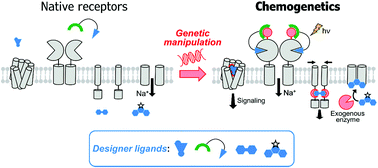
RSC Chem. Biol., 2022,3, 269-287
https://doi.org/10.1039/D1CB00195G
An overview of methods for the structural and functional mapping of epitopes recognized by anti-SARS-CoV-2 antibodies
This mini-review presents a critical survey of techniques used for epitope mapping on the SARS-CoV-2 Spike protein. An additional focus is an analytical appraisal of different deep mutational scanning workflows.
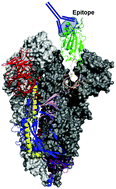
RSC Chem. Biol., 2021,2, 1580-1589
https://doi.org/10.1039/D1CB00169H
Segmental and site-specific isotope labelling strategies for structural analysis of posttranslationally modified proteins
Selective isotope labeling facilitates the analysis of effects of posttranslational modifications on protein structure and function.
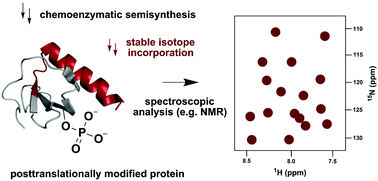
RSC Chem. Biol., 2021,2, 1441-1461
https://doi.org/10.1039/D1CB00045D
Targeting protein–protein interactions in the DNA damage response pathways for cancer chemotherapy
Targeting protein–protein interactions within the DNA damage response (DDR) pathways with small molecule inhibitors is reviewed here as a strategy to design novel cancer chemotherapeutics.
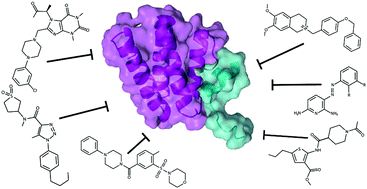
RSC Chem. Biol., 2021,2, 1167-1195
https://doi.org/10.1039/D1CB00101A
Aggregation of protein therapeutics enhances their immunogenicity: causes and mitigation strategies
Protein aggregation of biotherapeutics increases their immunogenicity, leading to immune-mediated adverse effects. In this review we discuss immune activation pathways, causes of aggregation and mitigation strategies.

RSC Chem. Biol., 2021,2, 1004-1020
https://doi.org/10.1039/D1CB00067E
Modulators of protein–protein interactions as antimicrobial agents
This review describes recent efforts towards the modulation of protein–protein interactions in infectious bacteria.

RSC Chem. Biol., 2021,2, 387-409
https://doi.org/10.1039/D0CB00205D
Metal transport mechanism of the cation diffusion facilitator (CDF) protein family – a structural perspective on human CDF (ZnT)-related diseases
A mechanistic analysis and structural perspective of cation diffusion facilitator (human ZnT) related diseases.
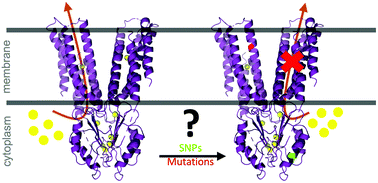
RSC Chem. Biol., 2021,2, 486-498
https://doi.org/10.1039/D0CB00181C
The chemical biology of coronavirus host–cell interactions
Chemical biology strategies can play important roles in studying the complexity of SARS-CoV-2–host interactions at molecular level detail.

RSC Chem. Biol., 2021,2, 30-46
https://doi.org/10.1039/D0CB00197J
Neighborhood watch: tools for defining locale-dependent subproteomes and their contextual signaling activities
We discuss chemical-genetic means to mine locale-specific proteins of functional relevance and whose behaviors are pharmacologically malleable.
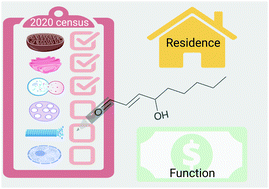
RSC Chem. Biol., 2020,1, 42-55
https://doi.org/10.1039/D0CB00041H
Protein–protein interaction based substrate control in the E. coli octanoic acid transferase, LipB
Lipoic acid, an essential cofactor produced in all organisms, diverts octanoic acid from type II fatty acid biosynthesis through a highly specific protein–protein interaction. This study characterizes how different substrates influence this interface to control chain length specificity.
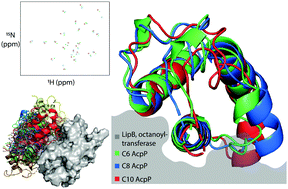
RSC Chem. Biol., 2021,2, 1466-1473
https://doi.org/10.1039/D1CB00125F
Aquaporin-driven hydrogen peroxide transport: a case of molecular mimicry?
The combination of advanced atomistic simulations provides complete analysis of the atomistic basis of molecular transduction of H2O2 across aquaporins.
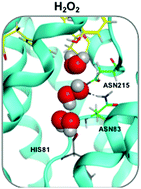
RSC Chem. Biol., 2020,1, 390-394
https://doi.org/10.1039/D0CB00160K
Biochemical and structural characterization of Haemophilus influenzae nitroreductase in metabolizing nitroimidazoles
The nitroreductase of Haemophilus influenzae metabolizes clinically used nitroimidazoles, generates dimeric metabolites and anaerobically sensitizes an E. coli mutant to antibiotics. We further uncover its biochemical and structural details.
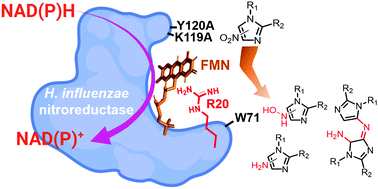
RSC Chem. Biol., 2022,3, 436-446
https://doi.org/10.1039/D1CB00238D
Computational design and experimental characterisation of a stable human heparanase variant
A mutant heparanase that exhibits wild type structure and activity but can be heterologously produced in bacterial protein expression systems.

RSC Chem. Biol., 2022,3, 341-349
https://doi.org/10.1039/D1CB00239B
The identification and characterization of an oxalyl-CoA synthetase from grass pea (Lathyrus sativus L.)
Kinetic and structural analysis of a novel oxalyl-CoA synthetase isolated from grass pea (Lathyrus sativus L.).
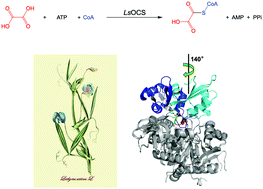
RSC Chem. Biol., 2022,3, 320-333
https://doi.org/10.1039/D1CB00202C
A COVID-19 vaccine candidate composed of the SARS-CoV-2 RBD dimer and Neisseria meningitidis outer membrane vesicles
Soberana01 is composed of the SARS-CoV-2 dimeric RBD and Neisseria meningitidis outer membrane vesicles (OMVs) adsorbed on alum. This vaccine induces a potent neutralizing immune response and shows potential against SARS-CoV-2 variants of concern.
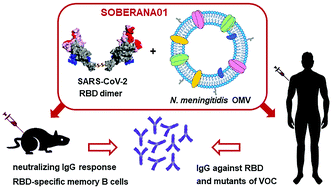
RSC Chem. Biol., 2022,3, 242-249
https://doi.org/10.1039/D1CB00200G
Identification of fragments binding to SARS-CoV-2 nsp10 reveals ligand-binding sites in conserved interfaces between nsp10 and nsp14/nsp16
By fragment screening using X-ray crystallography we identified four ligands revealing ligand-binding sites in interfaces between SARS-CoV-2 nsp10 and nsp14/nsp16. The nsp14/10 interaction is weak and therefore could be disrupted by small molecules.
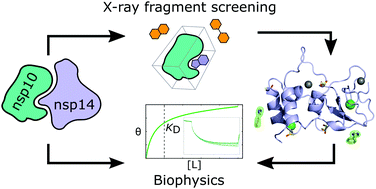
RSC Chem. Biol., 2022,3, 44-55
https://doi.org/10.1039/D1CB00135C
Origin, toxicity and characteristics of two amyloid oligomer polymorphs
Self-assembly of lysozyme can generate two amyloids oligomer polymorphs with distinct characteristics and toxicity. Both polymorphs are off-pathway from amyloid fibril assembly.

RSC Chem. Biol., 2021,2, 1631-1642
https://doi.org/10.1039/D1CB00081K
Members of the Legionella pneumophila Sde family target tyrosine residues for phosphoribosyl-linked ubiquitination
During infection, Legionella pneumophila translocates hundreds of effectors into host cells. Among these, the Sde family effector SdeC catalyzes atypical ubiquitination of host targets at tyrosine, not only serine, residues.
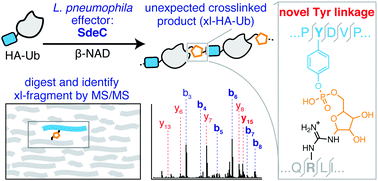
RSC Chem. Biol., 2021,2, 1509-1519
https://doi.org/10.1039/D1CB00088H
Computational design and experimental characterization of a photo-controlled mRNA-cap guanine-N7 methyltransferase
Guided by computational design, we engineered a light-dependent 5' cap guanine-N7 methyltransferase by bridging the substrate-binding cleft with an azobenzene derivative.

RSC Chem. Biol., 2021,2, 1484-1490
https://doi.org/10.1039/D1CB00109D
Lysine succinylation on non-histone chromosomal protein HMG-17 (HMGN2) regulates nucleosomal DNA accessibility by disrupting the HMGN2–nucleosome association
Succinylated HMGN2, prepared by a ‘thiol–ene reaction’, disrupted the association of HMGN2 with the nucleosome and increased nucleosomal DNA accessibility.
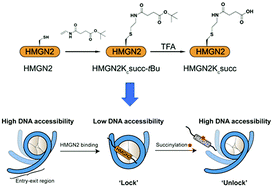
RSC Chem. Biol., 2021,2, 1257-1262
https://doi.org/10.1039/D1CB00070E
Elongation rate and average length of amyloid fibrils in solution using isotope-labelled small-angle neutron scattering
We demonstrate a solution method that allows both elongation rate and average length of amyloid fibrils to be independently determined.
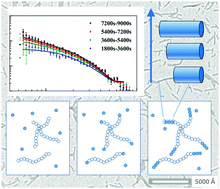
RSC Chem. Biol., 2021,2, 1232-1238
https://doi.org/10.1039/D1CB00001B
Mechanisms of allosteric and mixed mode aromatase inhibitors
Identification of multiple ligand binding sites in aromatase.
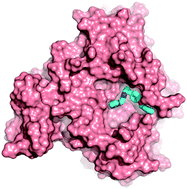
RSC Chem. Biol., 2021,2, 892-905
https://doi.org/10.1039/D1CB00046B
Intermediary conformations linked to the directionality of the aminoacylation pathway of nonribosomal peptide synthetases
In-solution analysis of conformational changes of NRPS adenylation and peptidyl-carrier protein domains under catalytic conditions reveals a new intermediary conformation.
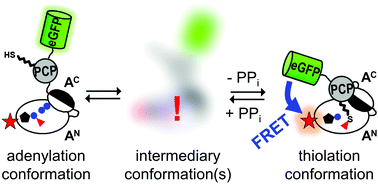
RSC Chem. Biol., 2021,2, 843-854
https://doi.org/10.1039/D0CB00220H
Membrane composition and lipid to protein ratio modulate amyloid kinetics of yeast prion protein
This study provides a mechanistic description of how the membrane composition and lipid to protein ratio modulate amyloid kinetics of yeast prion protein.
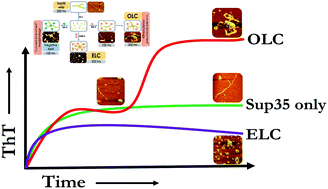
RSC Chem. Biol., 2021,2, 592-605
https://doi.org/10.1039/D0CB00203H
Combined computational and intracellular peptide library screening: towards a potent and selective Fra1 inhibitor
Here we describe library design coupled with computational and intracellular screening as an effective methodology to derive an antagonist that is selective for Fra1 relative to Jun counterparts.

RSC Chem. Biol., 2021,2, 656-668
https://doi.org/10.1039/D1CB00012H
Substrate inhibition by the blockage of product release and its control by tunnel engineering
Substrate inhibition can be caused by substrate binding to the enzyme–product complex and can be controlled rationally by targeting enzyme access tunnels.
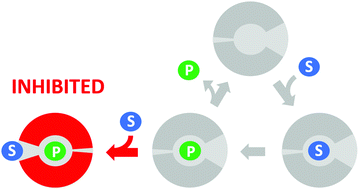
RSC Chem. Biol., 2021,2, 645-655
https://doi.org/10.1039/D0CB00171F
Protein degradation profile reveals dynamic nature of 20S proteasome small molecule stimulation
Small molecule stimulators of the 20S core particle of the proteasome can lead to the degradation of a variety of protein substrates.
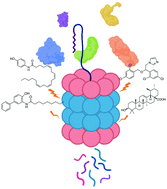
RSC Chem. Biol., 2021,2, 636-644
https://doi.org/10.1039/D0CB00191K
Site-specific modification and segmental isotope labelling of HMGN1 reveals long-range conformational perturbations caused by posttranslational modifications
Using protein semi-synthesis, segmentally isotope-labelled variants of nucleosome-binding protein HMGN1 were generated with site-specific posttranslational modifications to explore their structural and functional effects.

RSC Chem. Biol., 2021,2, 537-550
https://doi.org/10.1039/D0CB00175A
Bypassing the requirement for aminoacyl-tRNA by a cyclodipeptide synthase enzyme
Cyclodipeptide synthases recognize a minimalistic substrate to produce cyclic dipeptides in a tRNA-independent manner.
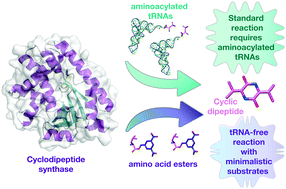
RSC Chem. Biol., 2021,2, 230-240
https://doi.org/10.1039/D0CB00142B
In silico peptide-directed ligand design complements experimental peptide-directed binding for protein–protein interaction modulator discovery
Using the protein–protein interaction of Mcl-1/Noxa, two methods for efficient modulator discovery are directly compared.
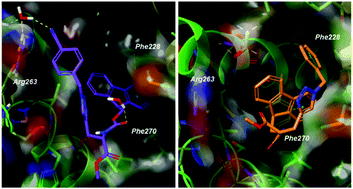
RSC Chem. Biol., 2021,2, 215-219
https://doi.org/10.1039/D0CB00148A
Met80 and Tyr67 affect the chemical unfolding of yeast cytochrome c: comparing the solution vs. immobilized state
The motional regime affects the unfolding propensity and axial heme coordination of the Met80Ala and Met80Ala/Tyr67Ala variants of yeast iso-1 cytochrome c.
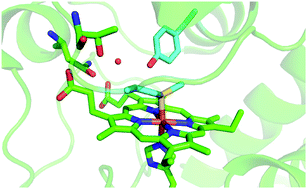
RSC Chem. Biol., 2020,1, 421-435
https://doi.org/10.1039/D0CB00115E
Sub-stoichiometric inhibition of IAPP aggregation: a peptidomimetic approach to anti-amyloid agents
Naphthalimide-appended oligopyridylamide peptidomimetic modulate islet amyloid polypeptide amyloidogenesis and disaggregate preformed oligomers and fibrils into non-toxic conformations at substoichiometric concentration.
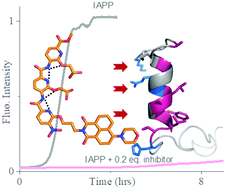
RSC Chem. Biol., 2020,1, 225-232
https://doi.org/10.1039/D0CB00086H
Haemoglobin(βK120C)–albumin trimer as an artificial O2 carrier with sufficient haemoglobin allostery
Recombinant haemoglobin [rHb(βK120C)] was coupled with two human serum albumins (HSAs), yielding a rHb(βK120C)–HSA2 heterotrimer, which shows a sigmoidal O2 equilibrium curve and sufficient Hb allostery identical to those of native Hb.
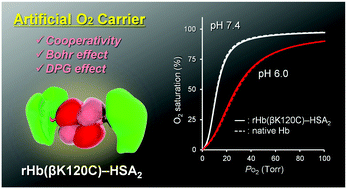
RSC Chem. Biol., 2020,1, 128-136
https://doi.org/10.1039/D0CB00056F
About this collection
The study of proteins, their structure and function, interactions and roles in disease is a vast topic encompassing a range of different approaches, techniques and tools. Work in this collection reflects the variety and scope of this area of chemical biology research, including studies on the mechanisms of aromatases, coronavirus host-cell interactions, the mapping of epitopes, and much more. Protein structure, function and protein-protein interactions are all included.
This collection intends to highlight the importance of multidisciplinary research at the chemistry-biology interface. Much of this exciting and ground-breaking research on proteins and their interactions is collated here for you to explore.
New articles on the topic will be added periodically.